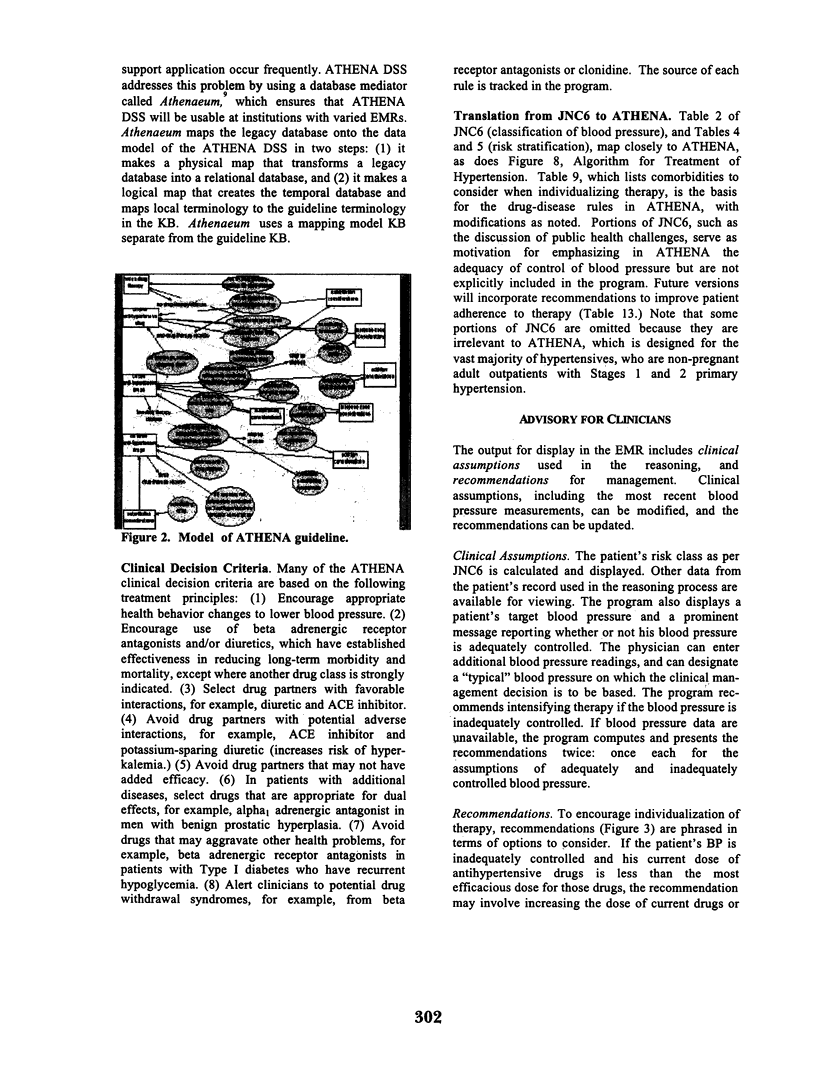Abstract
This paper describes the ATHENA Decision Support System (DSS), which operationalizes guidelines for hypertension using the EON architecture. ATHENA DSS encourages blood pressure control and recommends guideline-concordant choice of drug therapy in relation to comorbid diseases. ATHENA DSS has an easily modifiable knowledge base that specifies eligibility criteria, risk stratification, blood pressure targets, relevant comorbid diseases, guideline-recommended drug classes for patients with comorbid disease, preferred drugs within each drug class, and clinical messages. Because evidence for best management of hypertension evolves continually, ATHENA DSS is designed to allow clinical experts to customize the knowledge base to incorporate new evidence or to reflect local interpretations of guideline ambiguities. Together with its database mediator Athenaeum, ATHENA DSS has physical and logical data independence from the legacy Computerized Patient Record System (CPRS) supplying the patient data, so it can be integrated into a variety of electronic medical record systems.
Full text
PDF




Selected References
These references are in PubMed. This may not be the complete list of references from this article.
- Advani A., Tu S., O'Connor M., Coleman R., Goldstein M. K., Musen M. Integrating a modern knowledge-based system architecture with a legacy VA database: the ATHENA and EON projects at Stanford. Proc AMIA Symp. 1999:653–657. [PMC free article] [PubMed] [Google Scholar]
- Barnett G. O., Winickoff R. N. Quality assurance and computer-based patient records. Am J Public Health. 1990 May;80(5):527–528. doi: 10.2105/ajph.80.5.527. [DOI] [PMC free article] [PubMed] [Google Scholar]
- Bero L. A., Grilli R., Grimshaw J. M., Harvey E., Oxman A. D., Thomson M. A. Closing the gap between research and practice: an overview of systematic reviews of interventions to promote the implementation of research findings. The Cochrane Effective Practice and Organization of Care Review Group. BMJ. 1998 Aug 15;317(7156):465–468. doi: 10.1136/bmj.317.7156.465. [DOI] [PMC free article] [PubMed] [Google Scholar]
- Litzelman D. K., Dittus R. S., Miller M. E., Tierney W. M. Requiring physicians to respond to computerized reminders improves their compliance with preventive care protocols. J Gen Intern Med. 1993 Jun;8(6):311–317. doi: 10.1007/BF02600144. [DOI] [PubMed] [Google Scholar]
- McDonald C. J., Hui S. L., Smith D. M., Tierney W. M., Cohen S. J., Weinberger M., McCabe G. P. Reminders to physicians from an introspective computer medical record. A two-year randomized trial. Ann Intern Med. 1984 Jan;100(1):130–138. doi: 10.7326/0003-4819-100-1-130. [DOI] [PubMed] [Google Scholar]
- Musen M. A., Tu S. W., Das A. K., Shahar Y. EON: a component-based approach to automation of protocol-directed therapy. J Am Med Inform Assoc. 1996 Nov-Dec;3(6):367–388. doi: 10.1136/jamia.1996.97084511. [DOI] [PMC free article] [PubMed] [Google Scholar]
- Nielsen F. S., Rossing P., Gall M. A., Skøtt P., Smidt U. M., Parving H. H. Long-term effect of lisinopril and atenolol on kidney function in hypertensive NIDDM subjects with diabetic nephropathy. Diabetes. 1997 Jul;46(7):1182–1188. doi: 10.2337/diab.46.7.1182. [DOI] [PubMed] [Google Scholar]
- Oxman A. D., Thomson M. A., Davis D. A., Haynes R. B. No magic bullets: a systematic review of 102 trials of interventions to improve professional practice. CMAJ. 1995 Nov 15;153(10):1423–1431. [PMC free article] [PubMed] [Google Scholar]
- Tierney W. M., Hui S. L., McDonald C. J. Delayed feedback of physician performance versus immediate reminders to perform preventive care. Effects on physician compliance. Med Care. 1986 Aug;24(8):659–666. doi: 10.1097/00005650-198608000-00001. [DOI] [PubMed] [Google Scholar]
- Tierney W. M., Overhage J. M., Takesue B. Y., Harris L. E., Murray M. D., Vargo D. L., McDonald C. J. Computerizing guidelines to improve care and patient outcomes: the example of heart failure. J Am Med Inform Assoc. 1995 Sep-Oct;2(5):316–322. doi: 10.1136/jamia.1995.96073834. [DOI] [PMC free article] [PubMed] [Google Scholar]


